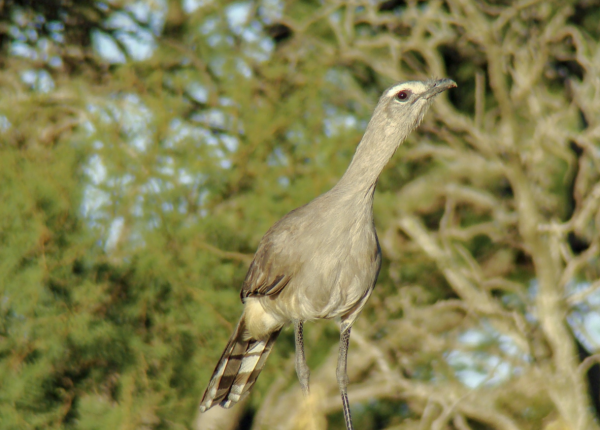Did You Know?
- The seriemas are the only known living relatives of the terror birds, an extinct group of very large, carnivorous, flightless birds.
- Though the Black-legged Seriema spends most of its time on the ground, it is able make short flights into low trees
- Researchers have observed this species feeding on grasses and other vegetable matter
How The Peregrine Fund is Helping
Researchers from The Peregrine Fund helped expand the definition of what makes a raptor a raptor, which helped get seriemas added to the list. Additionally, our efforts in scientific research, habitat conservation, education, and community development help conserve raptors around the world. We also supply literature to researchers from our avian research library, which helps scientists the world over gather and share important information on raptor conservation. We also support the Neotropical Raptor Network, which helps conserve raptors by fostering collaboration and communication among raptor enthusiasts in the region.
Where They Live
The Black-legged Seriema is found in a relatively small area within South America. It is endemic to the Chaco region, and can be found in the countries of Bolivia, where it was first documented in 1979, Argentina, and Paraguay. This lowland species spends its time in more open forests, drier woodlands, and savannas.
What They Do
The Black-legged Seriema is one of the largest ground-dwelling birds in South America. If you are ever in this bird's territory, make sure to listen closely, especially in the earliest part of the day, for its distinctive calls, that have been compared to the barking of a dog, or the call of a wild turkey. When one bird starts calling, sometimes individuals in nearby territories will call back in response.
These birds have long legs, which are perfect for spending a lot of time walking on the ground. This bird frequents pastures, hanging around near horses and other livestock. They might be waiting nearby for these large mammals to scare up insects or any other favorite prey items. Though it is capable of flying, it appears to do so only when absolutely necessary, and prefers to use its long legs to speedily chase prey and flee from predators.
Why They Need our Help
Thankfully, the Black-legged Seriema is categorized as a species of Least Concern. This is probably due to the fact that its population appears to be stable. Up until recently, some people that lived near this bird hunted them and collected their eggs. Today, there is still so much we need to learn about this species.
What They Eat
The Black-legged Seriema is an omnivore - this means it eats just about anything small enough for it to catch. It has a long list of items on its menu including large insects, such as grasshoppers and beetles, as well as lizards, snakes, rodents, and small birds. It will also feed on seeds and other plant material.
Nests, Eggs, and Young
Not much is known about the nesting habits of the Black-legged Seriema. We know that they build stick nests in low branches of trees or in bushes. The female will lay 2-3 eggs that are white with some greyish markings, though in most studies nests, researchers have documented only one nestling.
Black-legged Seriema and the World Center for Birds of Prey
The World Center for Birds of Prey offers fun ways to learn about raptors. The visitor center has interactive displays, tours, interesting videos and a children's room with activities from coloring sheets to quizzes to costumes and a touch table for the curious mind. We also have a number of avian ambassadors on hand which gives you a chance to see some birds of prey up close. Knowledgeable staff and volunteers are on hand to answer any questions you may have about Black-legged Seriemas or any other bird of prey.
References:
BirdLife International. 2016. Chunga burmeisteri. The IUCN Red List of Threatened Species 2016: e.T22692208A93341490. https://dx.doi.org/10.2305/IUCN.UK.2016-3.RLTS.T22692208A93341490.en. Downloaded on 28 August 2021.
Gonzaga, L. P., G. M. Kirwan, and E. de Juana (2020). Black-legged Seriema (Chunga burmeisteri), version 1.0. In Birds of the World (J. del Hoyo, A. Elliott, J. Sargatal, D. A. Christie, and E. de Juana, Editors). Cornell Lab of Ornithology, Ithaca, NY, USA. https://doi.org/10.2173/bow.bllser1.01
McClure, C., S. Schulwitz, D. Anderson, B. Robinson, E. Mojica, JF Therrien, M. Oleyar, and J. Johnson. 2019. Commentary: Defining Raptors and Birds. Journal of Raptor Research. DOI: 10.3356/0892-1016-53.4.419
Schmitt, C.G. and Cole, D.C., 1981. First Records of Black-Legged Seriema (Chunga burmeisteri) in Bolivia. The Condor, 83(2), pp.182-183.







